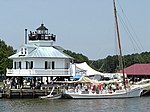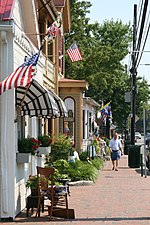Chesapeake Bay Maritime Museum
1965 establishments in MarylandChesapeake Bay Maritime MuseumHistoric American Engineering Record in MarylandInstitutions accredited by the American Alliance of MuseumsMaritime museums in Maryland ... and 4 more
Museums established in 1965Museums in Talbot County, MarylandOpen-air museums in MarylandSaint Michaels, Maryland

The Chesapeake Bay Maritime Museum is located in St. Michaels, Maryland, United States and is home to a collection of Chesapeake Bay artifacts, exhibitions, and vessels. This 18-acre (73,000 m2) interactive museum was founded in 1965 on Navy Point, once a site of seafood packing houses, docks, and work boats. Today, the museum houses the world's largest collection of Chesapeake Bay boats and provides interactive exhibits in and around the 35 buildings which dot the campus. The museum also offers year-round educational seminars and workshops.
Excerpt from the Wikipedia article Chesapeake Bay Maritime Museum (License: CC BY-SA 3.0, Authors, Images).Chesapeake Bay Maritime Museum
North Talbot Street,
Geographical coordinates (GPS) Address Website External links Nearby Places Show on map
Geographical coordinates (GPS)
| Latitude | Longitude |
|---|---|
| N 38.787343 ° | E -76.220229 ° |
Address
Chesapeake Bay Maritime Museum
North Talbot Street 213
21663
Maryland, United States
Open on Google Maps






